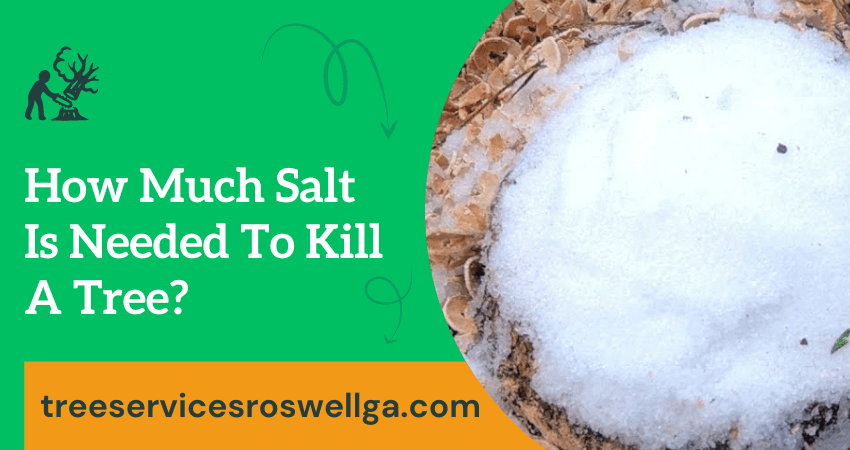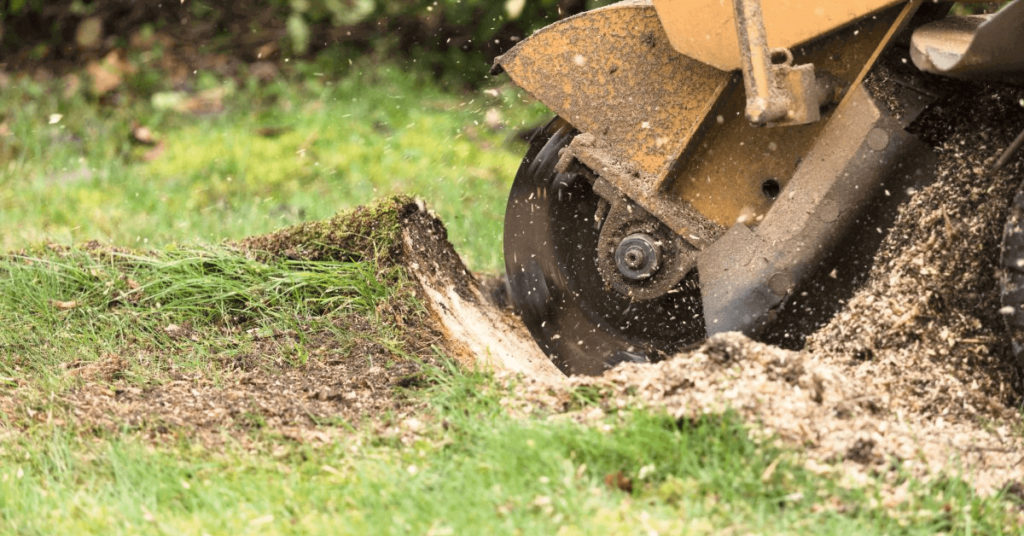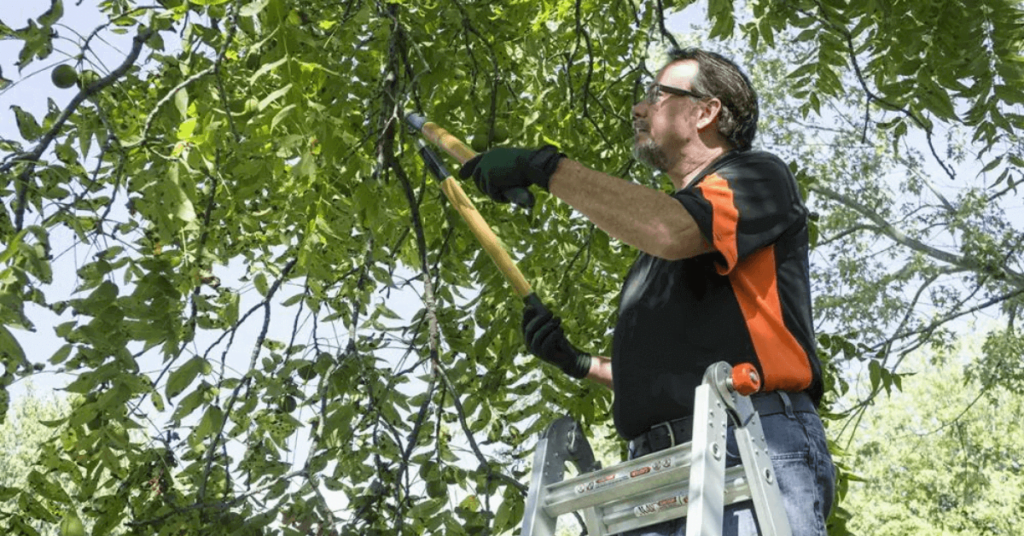Salt is a commonly used substance in many industries and is also used in many households as a seasoning and preservative. Salt is used as a de-icing agent on roads, sidewalks and driveways during the winter. However, salt can have detrimental effects on plants and trees if used in excessive amounts.
In this blog post, we’ll focus on the effects of salt on trees and the amount of salt needed to kill a tree. We will also explore the different methods of applying salt to a tree and the factors that affect the effectiveness of using salt to kill a tree.
How Much Salt Is Needed To Kill A Tree?
Salt is a powerful tool for killing trees, but it must be used carefully. The amount of salt needed to kill a tree varies depending on the species, age and health of the tree. Generally speaking, larger quantities are needed for trees that are more mature or in better health.
Salt is most effective when it is applied directly to the base of the tree’s trunk, as it can then be absorbed by its root system. If salt is spread on the ground around the tree, only a fraction of it will eventually reach the roots.
Using too much salt can also damage other vegetation in your yard or garden, so it’s important to use the correct amount. As a general rule of thumb, spray one cup of salt solution (one part salt to eight parts water) per square foot of soil around the base of the tree. The exact quantity may need to be adjusted based on your particular tree and environment.
Salt affect tree growth and health
- Salt can reduce the amount of water available to trees, causing them to become stressed and potentially unhealthy.
- High levels of salinity can inhibit the ability of a tree’s root system to absorb nutrients from the soil, leading to nutrient deficiencies.
- Excess salt in the soil can damage or kill sensitive root cells, making it difficult for the tree to take up water and absorb nutrients.
- Salt can also interfere with a tree’s ability to photosynthesize, meaning that the leaves of a salt-stressed tree will produce fewer sugars and other carbohydrates important for growth.
- High levels of salt can cause leaf burn and even death of limbs and branches if left untreated.
- Salt can also increase the risk of disease, as it creates an environment where bacteria and fungi are more likely to flourish.
- Trees exposed to salt may also suffer from a decrease in overall vigor and productivity, with fewer flowers, fruits or leaves produced than normal.
Concentration of salt is needed to cause damage to trees
Salt can be very damaging to trees and the amount of salt needed for damage depends on many factors. For example, some tree species are more tolerant of salt than others; likewise, soil type, drainage rates and other environmental conditions will affect the accumulation of salt in the soil and therefore its potential effects on trees.
Generally speaking, a salt concentration of 0.2% or higher can cause damage to trees, while a salt concentration below 0.1% is usually non-toxic.
However, it is important to note that even low levels of salt can cause damage over time as the accumulation rate increases. Additionally, certain species and soil types may require lower concentrations for toxic effects, so salt levels should be monitored closely.
In cases where salt levels are too high, soil leaching or flushing can help reduce the concentration of salt in the soil and protect trees from potential damage. Overall, it is important to be aware of the salt concentration in soil and take measures to protect trees from potential damage.
4 Methods of using salt to kill a tree
There are four main methods used to kill a tree using salt:
1) Spraying a salt solution
This is the most common method of killing a tree with salt. Mix one cup of salt in one gallon of water and spray the solution onto the leaves and bark of the tree. This will prevent photosynthesis and eventually cause the tree to die.
2) Pouring salt around the base
Another popular method is to pour salt around the base of the tree. To do this, mix two cups of salt in one gallon of water and pour the solution around the tree trunk. This will prevent the tree from absorbing moisture and other essential nutrients, causing it to eventually die.
3) Injecting salt into the tree trunk
The third and most effective method is to inject salt directly into the tree trunk. To do this, you need to drill several small holes around the trunk and inject the salt solution using a syringe or needle. This will cause the tree to starve of essential nutrients and die.
4) Direct application of salt
You can also directly apply salt to the tree. To do this, sprinkle the salt around the base of the tree and on its leaves and bark. This will cause dehydration and eventually kill the tree.
Using any of these methods, you can effectively kill a tree using salt. It is important to remember that all these methods are highly effective, so it is best to use caution when trying them out. Overall, using salt to kill a tree is an effective method and should only be used as a last resort.
Factors that affect the effectiveness of using salt to kill a tree
There are the main factors that affect how effective salt is in killing a tree:
- Application of salt: Applying too much or too little salt can significantly reduce its effectiveness in killing a tree. To ensure maximum results, it is important to apply an even and liberal amount of salt around the base of the trunk.
- Weather conditions: If it has not been raining for a few days before applying the salt, then it is likely that the salt will quickly dry out when exposed to direct sunlight. In these cases, more salt should be applied to ensure that enough of the salt reaches the roots of the tree and eventually kills it.
- Soil conditions: The type of soil that the tree is planted in can affect how effective salt will be. Soil with a high clay content may not allow enough of the salt to seep down to the roots, resulting in minimal damage to the tree.
- Tree species: Different species of trees are more vulnerable to salt than others. Evergreen species are particularly vulnerable due to their shallow root systems and need for a greater amount of moisture.
- Time: It can take several weeks or even months before the tree will die after applying salt, so patience is key when using salt as a tree killer.
How to prevent trees from Salt Damage?
Salt damage to trees is an ongoing problem that can cause a variety of problems for the health and growth of your tree. It’s important to take steps to protect your tree from salt damage.
- Plant trees away from roads, driveways and other areas where salt is commonly used.
- Wash trees off regularly with a garden hose to remove any salt residue or buildup.
- Mulching can also help reduce salt damage. Mulch helps retain moisture, reducing the amount of salt in the soil and protecting the tree’s roots from damage.
- Alternative deicing methods that are less harmful to trees are available. Examples include sand, kitty litter, sawdust and wood chips.
- Consider planting a variety of trees that are more tolerant of salt than other species. Species such as red maple and Norway spruce are more tolerant to salt than other trees.
Steps to take if a tree is already showing signs of salt damage
- Check the soil around the tree for high salinity levels. If the levels are greater than 10%, then it is likely that salt damage is occurring.
- Prune off any affected branches and leaves, taking extra care to ensure that no healthy branches or leaves are removed.
- Provide the tree with extra water and nutrients to help it recover from salt damage. Make sure to water deeply and frequently and use fertilizers specifically formulated for trees affected by salt damage.
- Install a barrier such as ground cover around the base of the tree to reduce further salt absorption from the soil.
- If possible, move the tree to a location with lower salinity levels. This may involve uprooting the tree and replanting it in a better-suited area.
- Monitor the health of the tree regularly and take steps to address any further signs of salt damage as soon as they appear.
- Seek professional help if the damage is severe and the tree does not seem to recover. A professional arborist can advise on further steps, including potential treatments and soil amendments.
By taking all of these steps, you can help your tree survive and thrive despite salt damage. Remember, prevention is always the best way to protect your trees from salt damage.
Wrap Up
Salt is an effective tree killer and only a small amount is needed. Just one tablespoon of salt per gallon of water can be enough to kill a small plant. Older trees may require more salt, but the type of salt that you use is also important.
Rock salt or table salt will not work as well as Epsom salts or kosher salts. It is important to keep in mind that this method should only be used as a last resort when all other options have failed.
This method can harm the environment and potentially other plants and animals nearby. If you need to remove a tree, it is best to consult with a professional who can safely and effectively remove it without damaging the surrounding area.
We hope this information has been useful in understanding salt damage and how to protect your trees from further harm. Thank you for taking the time to learn more about this important topic!



